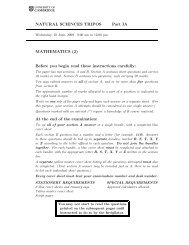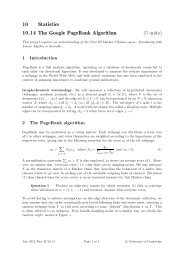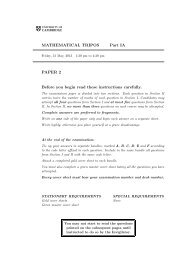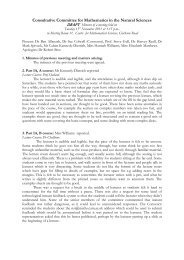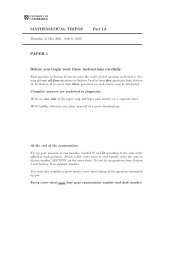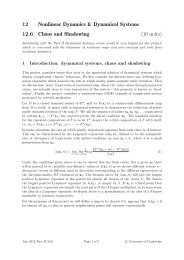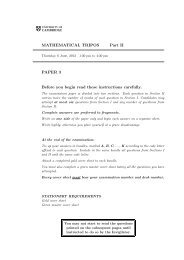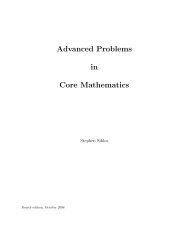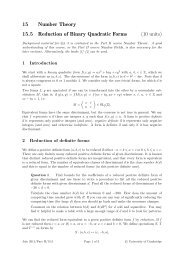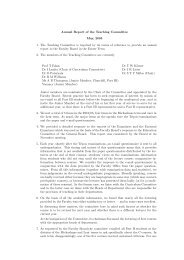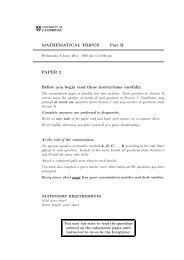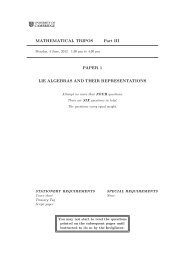MATHEMATICAL TRIPOS Part II PAPER 4 Before you begin read ...
MATHEMATICAL TRIPOS Part II PAPER 4 Before you begin read ...
MATHEMATICAL TRIPOS Part II PAPER 4 Before you begin read ...
- No tags were found...
You also want an ePaper? Increase the reach of your titles
YUMPU automatically turns print PDFs into web optimized ePapers that Google loves.
19<br />
34C Statistical Physics<br />
Non-relativistic electrons of mass m are confined to move in a two-dimensional plane<br />
of area A. Each electron has two spin states. Compute the density of states g(E) and<br />
show that it is constant.<br />
Write down expressions for the number of particles N and the average energy 〈E〉<br />
of a gas of fermions in terms of the temperature T and chemical potential µ. Find an<br />
expression for the Fermi Energy E F in terms of N.<br />
For k B T ≪ E F , <strong>you</strong> may assume that the chemical potential does not change with<br />
temperature. Compute the low temperature heat capacity of a gas of fermions. [You may<br />
use the approximation that, for large z,<br />
∫ ∞<br />
0<br />
x n dx<br />
z −1 e x + 1 ≈ 1<br />
n + 1 (log z)n+1 + π2 n<br />
6 (log z)n−1 .]<br />
35B Electrodynamics<br />
The charge and current densities are given by ρ(t, x) ≠ 0 and j(t, x) respectively.<br />
The electromagnetic scalar and vector potentials are given by φ(t, x) and A(t, x) respectively.<br />
Explain how one can regard j µ = (ρ, j) as a four-vector that obeys the current<br />
conservation rule ∂ µ j µ = 0.<br />
In the Lorenz gauge ∂ µ A µ = 0, derive the wave equation that relates A µ = (φ, A)<br />
to j µ and hence show that it is consistent to treat A µ as a four-vector.<br />
In the Lorenz gauge, with j µ = 0, a plane wave solution for A µ is given by<br />
where ǫ µ , k µ and x µ are four-vectors with<br />
Show that k µ k µ = k µ ǫ µ = 0.<br />
A µ = ǫ µ exp(ik ν x ν ) ,<br />
ǫ µ = (ǫ 0 , ǫ), k µ = (k 0 , k), x µ = (t, x) .<br />
Interpret the components of k µ in terms of the frequency and wavelength of the<br />
wave.<br />
Find what residual gauge freedom there is and use it to show that it is possible to<br />
set ǫ 0 = 0. What then is the physical meaning of the components of ǫ<br />
An observer at rest in a frame S measures the angular frequency of a plane wave<br />
travelling parallel to the z-axis to be ω. A second observer travelling at velocity v in S<br />
parallel to the z-axis measures the radiation to have frequency ω ′ . Express ω ′ in terms<br />
of ω.<br />
<strong>Part</strong> <strong>II</strong>, Paper 4<br />
[TURN OVER



